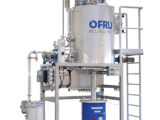Converting Paper market Size Forecast To Reach US$ 458.0 million by 2027
February 23, 2022Converting paper Market is designed, manufactured, and sold to meet customer needs in quality and processing suitability depending on application. Paper converting methods are used to create new products such as newsprint paper, writing paper, hygiene paper, packaging product, and different other variants from paper. Simply put, a paper converter takes one form of paper and fabricates it into another paper product. A paper converting often works with freezer paper, butcher paper, kraft paper, or linerboard to make paper products for different uses. For instance, a large paper roll can be printed, coated, and sheeted into custom-specified sandwich wrappers for a restaurant. The process of cutting rolls down is called converting. Converting paper finds variety of applications in sanitary and packaging industry.
Competitive Landscape:
Major players operating in the global converting paper market are Delta Paper Corp., Stora Enso Oyj, Mitsubishi Paper Mills Limited, Verso Corporation, Clearwater Paper Corporation, Catalyst Paper Corporation, BillerudKorsnäs AB, UPM-Kymmene Oyj, Twin Rivers Paper Company Inc., Domtar Corporation, Canfor Corporation, Asia Pacific Resources International Holdings Ltd., American Eagle Paper Mills, P.H. Glatfelter Co., Rolland Enterprises Inc., Alberta Newsprint Company Ltd., Burgo Group SPA, Finch Paper LLC, Georgia-Pacific LLC, and International Paper Company.
Key Market Drivers:
Increasing demand for personal hygiene products worldwide is expected to boost the growth of the converting paper market during the forecast period. Converting paper is widely used to make hygiene paper products, such as baby diapers, tissue paper, and others. For instance, in April 2021, Huanlong Group officially launched the expansion project with an annual output of 50,000 tons of high-end tissue paper. The expansion has allowed Huanlong Group to exceed its annual production capacity of 100,000 tons of tissue paper and converting capacity.
Moreover, increasing demand for paper worldwide is expected to augment the growth of the converting paper market. Paper is a common and essential to produce magazines, notebooks, and print books, among others. For instance, according to the India Brand Equity Foundation (IBEF), in India, paper demand is expected to grow at 6.7% compounded annual growth rate to reach 20.8 million tons (MT) by 2021. The domestic demand, which stood at 17.1 million tonne in 2018, has seen a steady growth since 2008, when it stood at 9.3 million tonne.
COVID-19 Impact Analysis:
Owing to the outbreak of COVID-19, the demand for converting paper has witnessed a low in the market. As the governments announced total lockdown and the temporary shutdown of industries to curb the spread of the coronavirus. However, there is an increasing demand for personal hygiene products, such as pads, tampons, napkins or tissues, baby diapers and adult incontinence products, due to the increasing awareness among people about health and hygiene in the wake of the pandemic Hygiene papers are eco-friendly, lightweight, and transparent and they prevent spread of infection and disease. This in turn is expected to propel the growth of the converting paper market, worldwide.
Key Takeaways:
The converting paper market is expected to exhibit a CAGR of 2.5 % during the forecast period owing to the increasing demand for converting paper in both develop and developing countries. For instance, in April 2020, Paper Converting Machine Company (PCMC), part of Barry-Wehmiller, announced the launch of Smart TOUCH HMI, a new human-machine interface available on Forte tissue converting lines. It works much like mobile devices with swipe functionality, enabling a short learning curve and increased productivity.
Among regions, Asia Pacific is expected to witness robust growth in the converting paper market, owing to rapidly growing packaging industry and evolving e-commerce industry. There is an increasing demand for efficient packaging solutions in lightweight packaging formats across the packaging and e-commerce industry. India has been witnessing a surge in its e-commerce sector over the years. For example, according to IBEF, Indian packaging industry is riding on the e-commerce wave, Indian e-commerce market is expected to reach US$ 200 billion by 2026, from US$ 38.5 billion in 2017.
Important Features that are under Offering and Key Highlights of the Reports:
– Potential and niche segments/regions exhibiting
promising growth.
– Detailed overview of Market
– Changing market dynamics of the industry
– In-depth market segmentation by Type, Application, etc.
– Historical, current, and projected market size in terms of volume and value
– Recent industry trends and developments
– Competitive landscape of Market
– Strategies of key players and product offerings
???? ??????’? ????? ?????????? ??? ?? ???????:
✤ SWOT Analysis is used to define, assess, and analyse market competition by focusing on the world’s major manufacturers. The market is defined, described, and forecasted by type, application, and region.
✤ Examine the potential and advantages of the global and major regional markets, as well as the opportunities and challenges, as well as the constraints and risks.
✤ Determine whether market growth is being driven or hampered by trends and factors.
✤ Stakeholders will be able to assess market potential by identifying high-growth categories.
✤ Conduct a strategic analysis of each submarket’s growth trends and contribution to the market.
✤ Competitive developments in the market include expansions, agreements, new product launches, and acquisitions.
✤ To develop a strategic profile of the major players and conduct a thorough analysis of their growth strategies.
??? ????????? ?????????:
✔ In the next seven
years, what innovative technology trends should we expect?
✔ Which sub-segment
do you believe will grow the fastest over the next few years?
✔ By 2028, which
region is predicted to have the largest market share?
✔ What organic and
inorganic strategies are businesses employing to gain market share?

